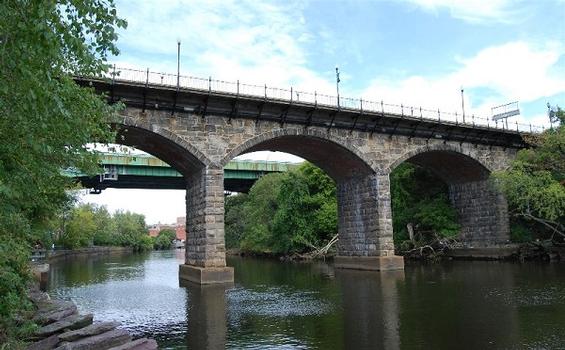General Information
| Completion: | 1878 |
|---|---|
| Status: | in use |
Project Type
| Structure: |
Segmental arch bridge |
|---|---|
| Material: |
Masonry bridge |
| Function / usage: |
Road bridge |
| Plan view: |
Structurae Plus/Pro - Subscribe Now! |
| Material: |
Structurae Plus/Pro - Subscribe Now! |
Awards and Distinctions
| 1983 |
for registered users |
|---|
Location
| Location: |
Pawtucket, Providence County, Rhode Island, USA |
|---|---|
| Coordinates: | 41° 52' 21.30" N 71° 23' 3.68" W |
Technical Information
Dimensions
| main span | 16.49 m | |
| total length | 136.22 m | |
| deck width | 7.89 m |
Excerpt from Wikipedia
The Division Street Bridge is an historic roadway and sidewalk stone arch bridge in Pawtucket, Rhode Island, carrying Division Street over the Seekonk River. The structure was built in 1875-1877 at a cost of USD$95,000. It is a nine-span stone and brick bridge with a total length of about 450 feet (140 m), making it the "finest and longest" stone arch bridge in the state. It is said to be a symbolic icon of the unity of the two neighborhoods, which are divided by the river, coming together as the Town of Pawtucket. The bridge was listed on the National Register of Historic Places in 1983. Although it may be "functionally obsolete" relative to traffic patterns and in need of repairs, it is considered to be architecturally and historically significant.
Design
The Division Street Bridge is a nine-span stone and brick structure, with a total length of about 450 feet (140 m).[A] Each of its spans consists of a segmented arch of about 50 feet (15 m) in length. The road bed is 27 feet (8.2 m) wide, and there are 7-foot (2.1 m) sidewalks on either side. The mean height of the bridge above the water is 45 feet (14 m). The piers of the bridge are constructed of coursed granite ashlar and the voussoirs are dressed granite with single keystones. The spandrels, the space between the arches, are filled with mortared granite rubble, and the arch barrels are constructed with an estimated 550,000 bricks. The original roadway was made of granite blocks, the seams of which were filled with tar, but this has been modified with modern asphalt paving and with the piers being modified with the addition of reinforced concrete sheathing for the river piers. The iron walkways, produced by Crowell and Sisson, project over both the sides of the bridge with iron brackets.
Constructed from 1875-77 at a cost of USD $95,000, the details of the bridge's construction and its architect are unknown. A contemporary account states that the need for the bridge was first proposed in 1871, but it wasn't until a town meeting on March 1, 1875 that it would be decided upon in a vote. A commission to oversee the project included C. B. Farnsworth, William T. Adams, and William R. Walker, and the contract was awarded to Horace Foster.[B] A local architect, William R. Walker was on the town's committee, but his role in the design or appearance of the bridge is unknown. Other figures involved in the construction of the bridge include Cushing and Company, later known as Cushing and Shedd, consulting engineers, and Horace Foster was the general contractor. Though it originally began as a contract for USD$71,000, the bridge would increase in costs to USD$95,000 due to the changes that were made. The granite was sourced from the towns of Sterling, Connecticut and Westerly, Rhode Island. Repairs for the bridge listed in the 1906 annual report recorded USD$15.82 for unspecified work. Though listed as only a footnote, repairs to the bridge were made in 1918.
Current state
The Division Street Bridge was last rehabilitated in 1985, but it remains open under no restrictions after its inspection in May 2012. Data from the National Bridge Inventory lists the superstructure and substructure as in fair condition. The scour condition is critical, but the recommended work is rehabilitation of the structure.[C]
The report estimates the cost of repairs to be USD$9,834,000. A collection of reports dating back to 1995 lists the bridge as "functionally obsolete" for its current traffic requirements. A 2006 traffic report listed the bridge as carrying 21,900 vehicles daily. In 2007 the historic bridge saw an increase in traffic, as a heavy truck detour during the reconstruction of the nearby I-95 Pawtucket Bridge. In 2012, the Pawtucket River Bridge reopened without weight restrictions to northbound traffic. The Division Street Bridge is used as part of a detour in the event of closure of the I-95 Pawtucket River bridge.
Significance
The Division Street Bridge is architecturally significant as the longest stone arch bridge in Rhode Island and historically significant as a symbolic gesture to link and unify the two rapidly growing neighborhoods on Pawtucket Falls under the newly formed Town of Pawtucket. The bridge was listed on the National Register of Historic Places in 1983.
Text imported from Wikipedia article "Division Street Bridge (Rhode Island)" and modified on July 23, 2019 according to the CC-BY-SA 4.0 International license.
Participants
Currently there is no information available about persons or companies having participated in this project.
Relevant Web Sites
- About this
data sheet - Structure-ID
20047969 - Published on:
25/08/2009 - Last updated on:
23/02/2022





